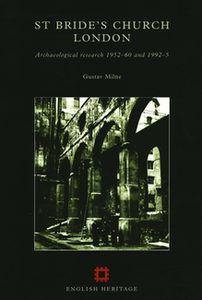English Heritage Archaeological Monographs
English Heritage, 2014. https://doi.org/10.5284/1028203. How to cite using this DOI
Data copyright © English Heritage unless otherwise stated
This work is licensed under the ADS Terms of Use and Access.
Primary contact
Historic England
The Engine House
Firefly Avenue
Swindon
SN2 2EH
Resource identifiers
- ADS Collection: 1416
- DOI:https://doi.org/10.5284/1028203
- How to cite using this DOI
St. Bride's Church London: Archaeological research 1952-60 and 1992-5
Milne, G.
English Heritage (1997)
Abstract:

One of the first English attempts to mount the total research excavation of an urban parish church, at blitz-damaged St Bride's in Fleet Street in the City of London, is recorded in this report. St Bride's foundation date is earlier than indicated by surviving documentary records and highlights the complexity of its subsequent development. Moreover, it demonstrates how archaeology can significantly extend the history of such a relatively well-documented building. Professor Grimes died before completing his definitive report, this report is as an attempt to make good that omission. It is an assessment of the surviving field records and a re-evaluation of 1950s finds, together with an account of building recording at St Bride's in 1992-3, conducted by a team from University College London. These excavations prove to be of more than local significance to medieval archaeologists. It was on the site of St Bride's that the concept of a parish church's research excavation was first evolved, after the rubble from dozens of churches bombed during the Second World War were usually carted away with little or no thought for archaeological recording. Among many problems faced were the logistics of opening up a large internal area and exposing large groups of burials. Evidence was found, not only at foundation level in the ground, but also in the standing fabric of the medieval building, elements of which survive in the present standing building. Detailed study of the finds recovered in 1952-4 also proved rewarding, and reports on the pottery, moulded stones tiles, grave covers, glass and coins are included.
Download monograph
| St. Bride's Church London: Archaeological research 1952-60 and 1992-5, Milne, G., English Heritage (1997), ISBN: 9781848022041 | 29 Mb |





